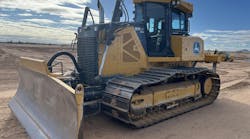Yuna Rapoport, M.D., an ophthalmologist specializing in cornea, refractive, and cataract surgery at Manhattan Eye in New York City, says unprotected welding can essentially cause an acute burn to the eyes—usually referred to as “arc flash” or “welder’s eye.” Both the cornea and conjunctiva (the white area of the eye) are affected.
Any welding or cutting type of activity that requires an arc or plasma beam can cause arc burn.
“It only takes a moment without protection to cause [arc flash],” Dr. Rapoport says. “The burn usually happens right away. The eyes might not react instantly, but by the time [the welder is] in my office, they're in a lot of pain. It can get worse as the day goes on.”
Depending on the duration and intensity of UV exposure, an injured welder will initially experience mild or severe pain within a few seconds to a few minutes after exposure. This can include visible symptoms such as bloodshot or watery eyes. Hours later, welders may begin experiencing intense tearing, sensitivity to light, or blurred vision. A feeling of grittiness in the eye, sometimes described as “the feeling of sand in the eyes,” may also occur.
In severe cases, the cornea will appear cloudy and opaque.
“At that point, the welder is essentially experiencing keratitis or photokeratitis, an eye condition that occurs when your eye is exposed to ultraviolet rays,” Dr. Rapoport says. “It literally feels like a sunburn on your eye. It’s incredibly painful.”
Without proper protection, workers can merely be in the proximity of a welding arc and still experience effects. Jerome Spear, a member of the American Society of Safety Professionals, works as a certified industrial hygienist and certified safety professional. He also worked at Chicago Bridge and Iron Company for nine years, where he gained hands-on welding experience.
Spear says he experienced arc flash working inside a pressure vessel they were building with various reflective alloy materials inside, such as stainless steel and inconel.
“I was a field engineer on a job, and since I was in an operating part of the plant, the customer required us to wear monogoggles...and they would fog up,” he says. “So I had pulled down my monogoggles for an extended period during the day, and there was welding going on inside of the vessel. I wasn’t directly exposed to the arc, but because the UV radiation reflected off the materials, I ended up experiencing arc flash.”
Kevin Beckerdite, global product manager at ESAB, says arc flash is more common than one might assume.
“A pretty substantial portion, if not everybody...doing welding on a full-time basis has experienced a flash from their arc device,” he says. “Hopefully it happens once and you remember to lower your shield, or your equipment is functioning properly...but any more than once and you’re not [going to be] happy.”
Photo credits:
stock.adobe.com / Andrey Burmakin
stock.adobe.com / ink drop
stock.adobe.com / Bannasak
Logos and product photos courtesy of ESAB & ASSP
Yuna Rapoport, M.D., an ophthalmologist specializing in cornea, refractive, and cataract surgery at Manhattan Eye in New York City, says unprotected welding can essentially cause an acute burn to the eyes—usually referred to as “arc flash” or “welder’s eye.” She sat down with Gianna Annunzio, Construction Equipment's Associate Editor, to discuss the risks and prevention tips. Photo Credits: stock.adobe.com / Andrey Burmakin stock.adobe.com / ink drop stock.adobe.com / Bannasak Logos and product photos courtesy of ESAB & ASSP
Yuna Rapoport, M.D., an ophthalmologist specializing in cornea, refractive, and cataract surgery at Manhattan Eye in New York City, says unprotected welding can essentially cause an acute burn to the eyes—usually referred to as “arc flash” or “welder’s eye.” She sat down with Gianna Annunzio, Construction Equipment's Associate Editor, to discuss the risks and prevention tips. Photo Credits: stock.adobe.com / Andrey Burmakin stock.adobe.com / ink drop stock.adobe.com / Bannasak Logos and product photos courtesy of ESAB & ASSP




